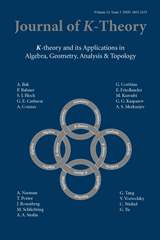Crossref Citations
This article has been cited by the following publications. This list is generated based on data provided by Crossref.
Hutchinson, Kevin
and
Wendt, Matthias
2014.
On the third homology of 𝑆𝐿₂ and weak homotopy invariance.
Transactions of the American Mathematical Society,
Vol. 367,
Issue. 10,
p.
7481.
Hutchinson, Kevin
2015.
On the low-dimensional homology of SL2(k[t,t−1]).
Journal of Algebra,
Vol. 425,
Issue. ,
p.
324.
Hutchinson, Kevin
2016.
The second homology of SL2 of S-integers.
Journal of Number Theory,
Vol. 159,
Issue. ,
p.
223.
Hutchinson, Kevin
2017.
The third homology of $$\mathrm {SL}_2$$ of local rings.
Journal of Homotopy and Related Structures,
Vol. 12,
Issue. 4,
p.
931.
Hutchinson, Kevin
2017.
The third homology of SL2 of fields with discrete valuation.
Journal of Pure and Applied Algebra,
Vol. 221,
Issue. 5,
p.
1076.
Mirzaii, Behrooz
2017.
A Bloch–Wigner exact sequence over local rings.
Journal of Algebra,
Vol. 476,
Issue. ,
p.
459.
Wendt, Matthias
2018.
Homology of SL2 over function fields I: Parabolic subcomplexes.
Journal für die reine und angewandte Mathematik (Crelles Journal),
Vol. 2018,
Issue. 739,
p.
159.
Karuo, Hiroaki
2021.
The reduced Dijkgraaf–Witten invariant of double twist knots in the Bloch group of 𝔽p.
Journal of Knot Theory and Its Ramifications,
Vol. 30,
Issue. 07,
Hutchinson, Kevin
2021.
The third homology ofSL2(Q).
Journal of Algebra,
Vol. 570,
Issue. ,
p.
366.
Karuo, Hiroaki
2021.
The reduced Dijkgraaf–Witten invariant of twist knots in the Bloch group of a finite field.
Journal of Knot Theory and Its Ramifications,
Vol. 30,
Issue. 03,
p.
2150014.
Hutchinson, Kevin
Mirzaii, Behrooz
and
Mokari, Fatemeh Y.
2022.
The homology of SL2 of discrete valuation rings.
Advances in Mathematics,
Vol. 402,
Issue. ,
p.
108313.
Hutchinson, Kevin
2024.
The Chern class for K3 and the cyclic quantum dilogarithm.
Journal of Algebra,
Vol. 649,
Issue. ,
p.
433.
Mirzaii, Behrooz
and
Torres Pérez, Elvis
2024.
A refined Bloch-Wigner exact sequence in characteristic 2.
Journal of Algebra,
Vol. 657,
Issue. ,
p.
141.
Mirzaii, Behrooz
and
Torres Pérez, Elvis
2024.
A refined scissors congruence group and the third homology of SL2.
Journal of Pure and Applied Algebra,
Vol. 228,
Issue. 6,
p.
107615.
Cuitún Coronado, Rodrigo
2024.
Third homology of SL2 over number fields: The norm-Euclidean quadratic imaginary case.
Journal of Pure and Applied Algebra,
Vol. 228,
Issue. 4,
p.
107515.
Ohtsuki, Tomotada
2025.
Low Dimensional Topology and Number Theory.
Vol. 456,
Issue. ,
p.
263.


